Cadency labels of the British royal family
Heraldic labels are used to differentiate the personal coats of arms of members of the royal family of the United Kingdom from that of the monarch and from each other. In the Gallo-British heraldic tradition, cadency marks have been available to "difference" the arms of a son from those of his father, and the arms of brothers from each other, and traditionally this was often done when it was considered important for each man to have a distinctive individual coat of arms and/or to differentiate the arms of the head of a house from junior members of the family. This was especially important in the case of arms of sovereignty: to use the undifferenced arms of a kingdom is to assert a claim to the throne. Therefore, in the English royal family, cadency marks were used from the time of Henry III, typically a label or bordure alluding to the arms of the bearer's mother or wife. After about 1340, when Edward III made a claim to the throne of France, a blue label did not contrast sufficiently with the blue field of the French quarter of the royal arms; accordingly most royal cadets used labels argent: that of the heir apparent was plain, and all others were charged.[1] Bordures of various tinctures continued to be used into the 15th century.
Label and charges |
The label
In the ordinary system of differences a label of three points (which has also been termed a label with three files) is the distinction of the eldest son during the lifetime of his father. In the oldest rolls of arms the labels are all of five points; but labels of three points were at an early period used interchangeably. Besides being used as mere temporary marks of cadency, labels are also employed as permanent distinctions, borne (like any other charge) by every member of some particular branches of certain families. Labels are the principal cadency marks used in certain royal families. In the British royal family, all labels are argent (white). The sons and daughters of the sovereign all bear labels of three points argent; that of the arms of the Prince of Wales is plain, but all others are charged. Further descendants of princes bear labels of five points charged. All such differences should be borne on the arms, crest, and supporters.
Charges
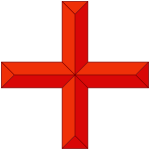 Red Cross |
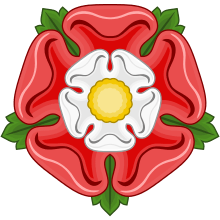 Rose |
 Heart |
.svg.png) Fleur-de-lis blue |
.svg.png) Anchor |
.svg.png) Thistle |
.svg.png) Trefoil |
Red Lion |
Ermine |
 Crown |
.svg.png) Escalope |
 Bee |
 Roundel |
|---|
The system of a special mark for difference for each member of the family goes back to the time of Henry III, whose successor, as a prince, placed such a mark on the shield of England. Since 1340 this label has almost always been white, and overlaid with small figures, or charges, such as red crosses of St George.[2] This red cross represents England and its patron saint, and was first borne by Richard of Bordeaux (future king Richard II) before the death of his father Edward, the Black Prince in 1376. Other charges used:
- A blue anchor, a symbol of hope, or of naval service, as borne by several Dukes of York.
- The Crown of England (sometimes called the Imperial or St Edward's Crown) borne by the abdicated king the Duke of Windsor, which is as unusual as the occurrence itself.
- Roses: the Tudor Rose (combined red and white) has been used as an English royal badge since 1485.
- Red hearts may allude to the arms of Lüneburg (part of the Hanoverian arms) or – for the descendants of Edward VII and Alexandra of Denmark – to the coat of arms of Denmark.
- The blue fleur-de-lis appears amongst the Royal Badges in England of the Stuarts.
- The thistle is an ancient badge of Scotland.
- The escallop shell was traditionally a token of pilgrimage on the Way of St James. The shell in the labels of The Duke of Cambridge and Prince Harry alludes to their mother's Spencer arms.
- The bee is a canting charge in the label of Princess Beatrice of York.
- The trefoil is a badge of Ireland, associated with St Patrick, who used it to illustrate the doctrine of the Trinity.
Labels used since the Hanoverian succession
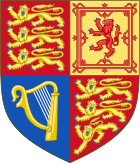 UK Arms since accession of Victoria, 1837
UK Arms since accession of Victoria, 1837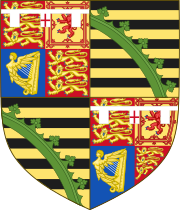 Albert, Prince Consort
Albert, Prince Consort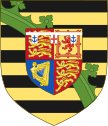 Prince Alfred (as Duke of Saxe-Coburg-Gotha)
Prince Alfred (as Duke of Saxe-Coburg-Gotha)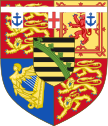 Prince Alfred (as Duke of Edinburgh)
Prince Alfred (as Duke of Edinburgh)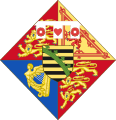 Princess Beatrice
Princess Beatrice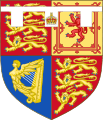 The Duke of Windsor
The Duke of Windsor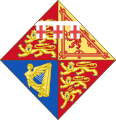 Mary, Princess Royal and Countess of Harewood
Mary, Princess Royal and Countess of Harewood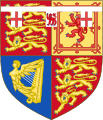 Prince Henry, Duke of Gloucester
Prince Henry, Duke of Gloucester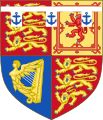 Prince George, Duke of Kent
Prince George, Duke of Kent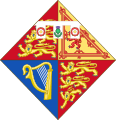 Princess Margaret
Princess Margaret Princess Alexandra
Princess Alexandra The Duke of Kent
The Duke of Kent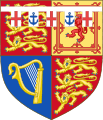 Prince Michael of Kent
Prince Michael of Kent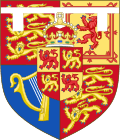 The Prince of Wales
The Prince of Wales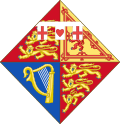 The Princess Royal
The Princess Royal The Duke of York
The Duke of York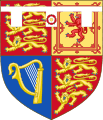 The Earl of Wessex
The Earl of Wessex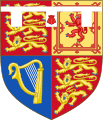 The Duke of Cambridge
The Duke of Cambridge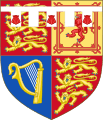 The Duke of Sussex
The Duke of Sussex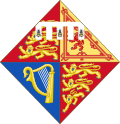 Princess Beatrice of York
Princess Beatrice of York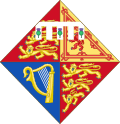 Princess Eugenie of York
Princess Eugenie of York
| King George I to Queen Victoria | |||||||||||||||||||
| Name | Title | Royal Warrant | Label argent[2][3] |
Notes | |||||||||||||||
|---|---|---|---|---|---|---|---|---|---|---|---|---|---|---|---|---|---|---|---|
| King George I (1660–1727) | Electoral Prince of Hanover British King from 1714. |
As George was never a cadet member of the British royal family, he never had such a label. | |||||||||||||||||
| Ernest (1674–1728) | Duke of York and Albany, Earl of Ulster | 1716 | Brother of George I. Bishop of Osnabrück. | ||||||||||||||||
| George (1683–1760) | Prince of Wales 1714 | Future King George II. | |||||||||||||||||
| Frederick (1701–1751) |
Duke of Gloucester 1718, Duke of Edinburgh 1726 | ||||||||||||||||||
| Prince of Wales 1729 | |||||||||||||||||||
| Anne (1705–1759) |
Princess Royal | 1719 | 2nd child, eldest daughter of George II. Princess of Orange-Nassau. | ||||||||||||||||
| 1727 | |||||||||||||||||||
| Amelia (1711–1786) |
1719 | ||||||||||||||||||
| 1727 | |||||||||||||||||||
| Caroline (1713–1757) | 1719 | ||||||||||||||||||
| 1727 | |||||||||||||||||||
| William (1721–1765) | 1725 | ||||||||||||||||||
| Duke of Cumberland 1726 | 1727 | ||||||||||||||||||
| Mary (1723–1772) | 1727 | ||||||||||||||||||
| Louise (1724–1751) | 1727 | Queen of Denmark and Norway | |||||||||||||||||
| Augusta (1737–1813) | 1813 | Duchess of Brunswick-Wolfenbüttel | |||||||||||||||||
| George (1738–1830) | 2nd Duke of Edinburgh, Prince of Wales 1751 | Future king George III | |||||||||||||||||
| Edward (1739–1767) | Duke of York and Albany 1760 | 1752 | |||||||||||||||||
| William (father) (1743–1805) | Duke of Gloucester and Edinburgh 1764 | ||||||||||||||||||
| Henry (1745–1790) | Duke of Cumberland and Strathearn 1766 | ||||||||||||||||||
| Frederick (1750–1765) | Posthumous | ||||||||||||||||||
| George (1762–1830) | Prince of Wales 1762 | Future King George IV | |||||||||||||||||
| Frederick (1763–1827) | Duke of York and Albany 1784 | ||||||||||||||||||
| William (1765–1837) | Duke of Clarence and St Andrews 1789 | 1781 | Future King William IV | ||||||||||||||||
| Charlotte (1766–1828) | Princess Royal | Queen of Württemberg | |||||||||||||||||
| Edward (1767–1820) | Duke of Kent and Strathearn 1799 | Father of Queen Victoria | |||||||||||||||||
| Augusta Sophia (1768–1840) | 1789 | ||||||||||||||||||
| Elizabeth (1770–1840) | 1789 | Landgravine of Hesse-Homburg | |||||||||||||||||
| Ernest Augustus (1771–1851) | Duke of Cumberland and Teviotdale 1799 | King of Hanover 1837 | |||||||||||||||||
| Augustus Frederick (1773–1843) | Duke of Sussex 1801 | ||||||||||||||||||
| Adolphus (1774–1850) | Duke of Cambridge 1801 | ||||||||||||||||||
| Mary (1776–1857) | 1789 | Duchess of Gloucester and Edinburgh | |||||||||||||||||
| Sophia (1777–1848) | 1789 | ||||||||||||||||||
| Amelia (1783–1810) | 1789 | ||||||||||||||||||
| Leopold of Saxe-Coburg-Gotha (1790–1865) | as consort of Princess Charlotte of Wales | Later first King of the Belgians | |||||||||||||||||
| Charlotte of Wales (1796–1817) | 1816 | ||||||||||||||||||
| Queen Victoria to Queen Elizabeth II | |||||||||||||||||||
| Alexandrina Victoria of Kent (1819–1901) | No known arms were assigned to her as Princess. | Future Queen Victoria | |||||||||||||||||
| Albert of Saxe-Coburg & Gotha (1819–1861) | Prince Consort | 1837 | Husband of Queen Victoria. Quartered these arms with his paternal arms of Saxony. | ||||||||||||||||
| Victoria (1840–1901) | Princess Royal | 1841 | German Empress | ||||||||||||||||
| Albert Edward (1841–1910) | Prince of Wales | 1841 | Future King Edward VII (1901) | ||||||||||||||||
| Alice (1843–1878) | 1858 | Grand Duchess of Hesse. | |||||||||||||||||
| Alfred (1844–1900) | Duke of Edinburgh | ? | Duke of Saxe-Coburg-Gotha | ||||||||||||||||
| Helena (1846–1923) | 1858 | Princess of Schleswig-Holstein. | |||||||||||||||||
| Louise (1848–1939) | 1858 | Duchess of Argyll | |||||||||||||||||
| Arthur (1850–1942) | Duke of Connaught and Strathearn | 1874 | |||||||||||||||||
| Leopold (1853–1884) | Duke of Albany 1881 | 1856 | |||||||||||||||||
| Beatrice (1857–1944) | 1858 | Princess of Battenberg. | |||||||||||||||||
| Albert Victor (1864–1892) |
Duke of Clarence and Avondale | 1890 | The firstborn son of Edward Prince of Wales, died in 1892. | ||||||||||||||||
| George (1865–1936) |
Duke of York | 1892 | Future King George V (1910) | ||||||||||||||||
| Prince of Wales | 1901 | ||||||||||||||||||
| Louise (1867–1931) | Princess Royal 1905 | 1889 | Duchess of Fife | ||||||||||||||||
| Victoria (1868–1935) | 1896 | ||||||||||||||||||
| Maud of Wales (1869–1938) | 1896 | Queen of Norway | |||||||||||||||||
| Alfred of Edinburgh (1874–1899) | ? | Hereditary Prince of Saxe-Coburg and Gotha | |||||||||||||||||
| Marie of Edinburgh (1875–1938) | ? | Queen of Romania | |||||||||||||||||
| Victoria Melita of Edinburgh (1876–1936) | ? | Grand-duchess of Hesse, later Grand-duchess of Russia | |||||||||||||||||
| Alexandra of Edinburgh (1878–1942) | ? | Princess of Hohenlohe-Langenburg | |||||||||||||||||
| Margaret of Connaught (1882–1920) | 1905 | Crown princess of Sweden | |||||||||||||||||
| Arthur of Connaught (1883–1938) | 1904 | ||||||||||||||||||
| Alice of Albany (1883–1981) | 1934 | Countess of Athlone | |||||||||||||||||
| Beatrice of Edinburgh (1884–1966) | ? | Duchess of Galliera. | |||||||||||||||||
| Charles Edward of Albany (1884–1954) | 2nd Duke of Albany | none | Duke of Saxe-Coburg and Gotha. Deprived of his British titles 1919. Never granted arms in right of the United Kingdom, but used the arms of Dominion of Saxe-Coburg and Gotha as was his right as its sovereign. | ||||||||||||||||
| Patricia of Connaught (1886–1974) | 1919 | Lady Patricia Ramsay | |||||||||||||||||
| Edward (1894–1972) |
Prince of Wales | 1911 | King Edward VIII, abdicated 1936 | ||||||||||||||||
| Duke of Windsor | 1937 | Unique use of a Crown for an abdicated monarch. | |||||||||||||||||
| Albert (1895–1952) | Duke of York 1920 | 1912 | Future King George VI (1936) | ||||||||||||||||
| Mary (1897–1965) | Princess Royal 1952 | 1921 | Countess of Harewood | ||||||||||||||||
| Henry (1900–1974) | Duke of Gloucester 1928 | 1921 | |||||||||||||||||
| George (1902–1942) | Duke of Kent 1934 | 1921 | |||||||||||||||||
| Alastair of Connaught (1914–1943) | 2nd Duke of Connaught and Strathearn | 1942 | Quarterly 1 and 4 his grandfather's arms; 2 Fife; 3 Duff. | ||||||||||||||||
| Elizabeth II | |||||||||||||||||||
| Philip (born 1921) | Duke of Edinburgh; Prince Consort | 1947–49: his arms included an inescutcheon of his ancestor Princess Alice (Grand Duchess of Hesse): the Royal Arms with a label as shown above.[4] | |||||||||||||||||
| Elizabeth (born 1926) | 1944 | Future queen Elizabeth II (1952) | |||||||||||||||||
| Margaret (1930–2002) | 1944 | Countess of Snowdon | |||||||||||||||||
| Edward of Kent (born 1935) | 2nd Duke of Kent | 1948 | |||||||||||||||||
| Alexandra of Kent (born 1936) | 1961 | Lady Ogilvy | |||||||||||||||||
| William of Gloucester (1941–1972) | 1962 | ||||||||||||||||||
| Michael of Kent (born 1942) | 1962 | ||||||||||||||||||
| Richard of Gloucester (born 1944) | 2nd Duke of Gloucester | 1962 | |||||||||||||||||
| Charles (born 1948) | Prince of Wales | 1958 | |||||||||||||||||
| Duke of Rothesay | 1974 | ||||||||||||||||||
| Anne (born 1950) | Princess Royal | 1962 | Formerly Mrs Mark Phillips | ||||||||||||||||
| Andrew (born 1960) | Duke of York | 1962/63 | |||||||||||||||||
| Edward (born 1964) | Earl of Wessex | 1983 | |||||||||||||||||
| William (born 1982) | Duke of Cambridge | 2000 | The escallop is taken from the arms of their mother Diana Spencer (1961–1997). | ||||||||||||||||
| Harry (born 1984) | Duke of Sussex | 2002 | |||||||||||||||||
| Beatrice of York (born 1988) | 2006 | Bee from the arms of her mother. The three bees are a canting of her first name. | |||||||||||||||||
| Eugenie of York (born 1990) | 2008 | Thistles from the arms of her mother. | |||||||||||||||||
See also
- Royal Supporters of England
- Royal Standards of England
References
- A Complete Guide to Heraldry by Arthur Charles Fox-Davies (1909), p. 494. (Online texts at https://archive.org/details/completeguidetoh00foxduoft or http://www7b.biglobe.ne.jp/~bprince/hr/foxdavies/index.htm .)
- Ottfried Neubecker & John Brooke-Little: Heraldry: Sources, Symbols and Meaning (1997). ISBN 0-316-64141-3. "Signs of Differencing" (pp. 96–97).
- François Velde: Marks of Cadency in the British Royal Family. Retrieved 7 December 2010.
- Boutell (page 219).
.svg.png)